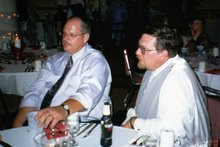Ben Sonnenberg, 25, was shot and killed by police outside a near east-sideThe story says that Sonneberg was shot multiple times in the back more than 10 feet from the car which had been stopped. No weapon was found at the scene of the shooting.
tavern early Saturday morning, when, according to Green Bay police, he made a
motion that looked as though he was reaching for a weapon.
Four well-trained law officers, including one who had reason to use deadly force once before, killed a young man based on their false belief that he was reaching for a weapon. Unfortunately, that can happen when you disobey a law enforcement officer. Sonnenberg's only actions should have been to stand very still and answer all of the questions put to him.
In an adrenaline-fueled situation like a traffic stop after a chase at bar time decisions are often made without benefit of complete information and those decisions have their own consequences. But there's more.
Bill Sonnenberg said he found numerous bullet holes in buildings near the crimeWhen adrenaline runs high there are often more shots fired than necessary and despite constant and ongoing training aim often suffers.
scene, including some as high as 7 or 8 feet.
A bystander — identified Sunday as Cesar J. Grijalva-Ortiz, 31 — also was shotPresident Bush said that the VT students were in the wrong place at the wrong time. They weren't. They were in the class in which they belonged. It was the gunman in the wrong place. In the Green Bay case it was Grijalva-Ortiz who was shot for being in a place at the wrong time.
and was taken to St. Vincent Hospital. Hospital nurse supervisor Patti Wauters
confirmed he hadn't been discharged as of Sunday afternoon but declined to give
further information. Police said Saturday they believed his injuries were not
life-threatening.
What does all of this have to do with VT? There are those who say that one more armed student in the lecture hall could have prevented much of the carnage. Is that case likely? What are the chances that only one more gun would have been present? What are the chances that the armed students would have been any better at target identification than the Green Bay officers? Would they have been more accurate? Faced with more than two shooters in an unexpected place could an armed student have been conditioned to only fire at the first shooter or would she have fired at anyone with a gun?
A prof at UW Madison did an exercise 25 years ago. During a lecture session, without warning, a person previously unknown to the class ran in from the side door, pulled a banana from his pocket, pointed it at the Prof and shouted, "Bang." The Professor fell down and the assailant ran from the room.
There were 140 different versions of what had happened in those 20 seconds of class. More than half swore that they had seen a gun. Nearly a quarter had heard a shot.
Panicked people do not make wise decisions. In the free for all atmosphere of a public shooting we could only expect the tragedy to be compounded by the presence of more weapons.
Four well-trained police officers managed to shoot two unarmed men and several buildings in the heat of the moment. How many would have been killed in a shootout in a lecture hall? It's impossible to say. That's why the CCW crowd's argument should carry no weight.



No comments:
Post a Comment